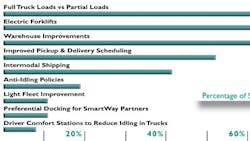Shifting More Freight to Rail Isn't Always Such a Great Idea
The U.S. government has introduced various incentives to motivate companies to use rail transportation more often to move their freight, with the goal of a greener transportation system throughout the country. However, there's no real evidence that greenhouse gas (GHG) emissions would be reduced by forcing truck traffic onto the rails, says Nol Perry, managing director and senior consultant with FTR Associates. In fact, it's quite the contrary -- most freight currently moving by truck would consume more energy if converted to a 100% rail move, he points out.
"Existing market forces have already done an excellent job of maximizing fuel efficiency by allowing rail and trucks to do what they do best," Perry says. Although generally speaking, the railroads are more fuel-efficient than motor carriers, that's just one part of the energy equation. Achieving the goal of optimal energy efficiency requires a complete supply chain analysis, which includes looking at local pick-ups and deliveries functions, for which trucks are far more efficient than rail.
Perry suggests that maximum energy efficiency is possible through such supply chain best practices as transloading freight between motor carriers and rail, where trucks are used for local transport and rail for intercity movements. The government should concentrate on creating more truck/rail interchange terminals to make this option more accessible, he says.
In addition, legislators should modify the truck size and weight standards, which have not been updated in more than 20 years, even though truck safety equipment has improved significantly in that time. As Perry sees it, energy efficiency and safety can both be improved by the operation of larger but fewer trucks. The government should also consider applying current truck standards for nitrous oxide (NOx) emissions to the railroads, particularly since rail locomotives produce 4.5 times more NOx -- a far more potent GHG than carbon dioxide -- than trucks, he adds.
Techniques and Strategies Used to Reduce Fuel Consumption and Emissions That Are Associated with Freight Shipping ActivitiesSee Also
About the Author
Dave Blanchard
Senior Director of Content
Focus: Supply Chain
Call: (941) 208-4370
Follow on Twitter @SupplyChainDave
During his career Dave Blanchard has led the editorial management of many of Endeavor Business Media's best-known brands, including IndustryWeek, EHS Today, Material Handling & Logistics, Logistics Today, Supply Chain Technology News, and Business Finance. He also serves as senior content director of the annual Safety Leadership Conference. With over 30 years of B2B media experience, Dave literally wrote the book on supply chain management, Supply Chain Management Best Practices (John Wiley & Sons, 2010), which has been translated into several languages and is currently in its second edition. He is a frequent speaker and moderator at major trade shows and conferences, and has won numerous awards for writing and editing. He is a voting member of the jury of the Logistics Hall of Fame, and is a graduate of Northern Illinois University.
